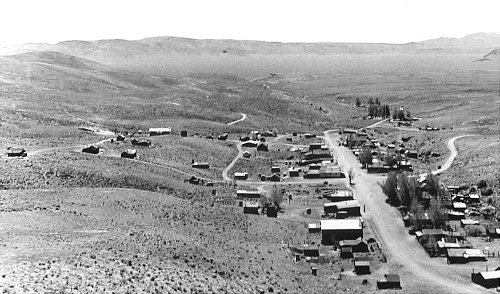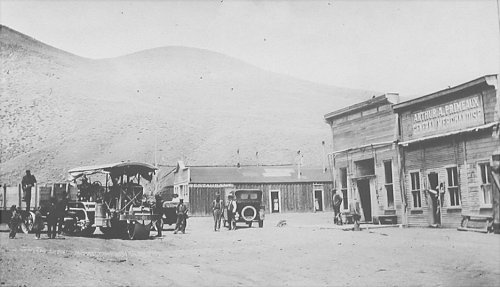HOWARD
HICKSON'S HISTORIES
[Index]
Halley's Comet
Midas, Nevada - April 27, 1910
Residents of Midas, a gold camp in Elko County,
were jolted from bed at 3:30 a.m. on April 27, 1910, when a blast rocked
the countryside and shook buildings.
Running from their houses and cabins, still
in their gowns and nightshirts, they heard a voice in the darkness, "Everybody
up! Halley's comet is about to appear!"
Tousled heads and bleary eyes turned toward
a nearby hill just east of town as a very bright light appeared. They were
suddenly awake and watched in amazement and wonder as the light lit the
sky for about twenty minutes. Then it faded away and the morning star appeared.
It was indeed a beautiful sight.

Midas around the time when Halley's Comet visited the place. Photograph
from the Northeastern Nevada Museum collections, Elko.
Everyone was thrilled. Sighting the famed comet
was a once in a lifetime event. It crosses the sky only about once every
75 years, give or take a couple of years. The great American humorist Mark
Twain claimed to have been born during the comet's last sighting in 1835
and maintained that he would leave this life when it next appeared.
Wide awake now but hoping to salvage a little
sleep, Midas residents went back to bed. They would learn, when the news
reached Midas a couple of days later, that Twain had passed away on April
21. Close enough, most commented.
Dick Avery, a night shift miner at the
Rex Mine, harbored a secret most the of following day. After getting a
snoot full at one of the bars, he told all about the previous night when
Halley's Comet visited Midas.
He had gotten a long pole about thirty
feet in length. After fastening a bundle of waste cloth on one end, he
saturated it with oil then detonated a stick of dynamite to wake the town.
After announcing the comet's coming,
he raced to the hill top which was, more or less, the proper direction
for sighting the celestial wonder. He lit the torch and proceeded to fake
the miracle of the heavens. He did such a good job that everyone, bar none,
thought they had seen the famous comet.
Many of those who had walked a half
mile or so to view Avery's Comet were not entirely pleased about the hoax.
In fact, some were outright mad. Others chuckled at the joke played on
them. After all, it put some excitement and fun into a sometimes dull life
of a remote mining camp.

Downtown Midas
around 1928.
Photograph from the Northeastern Nevada Museum
collections, Elko.
On April 28, 1910, the real comet was first
sighted by the naked eye and was seen nightly until the end of June. May
10 was the night it was closest to earth, only 14,300,000 miles away.
Midas was named for the legendary Greek
king whose touched turned everything to gold. Before that it was called
Gold Circle and Summit, at different times, of course.
Midas citizens have put together a museum
in the old school there. It is worth the trip to visit the town. Although
there are still mining operations nearby, the flavor and personality of
the old mining camp are still there.
Howard Hickson
April 21, 2001
Sources: Much of the research for this article was done
more than twenty years ago by Claudia Riordan when she was on the staff
of the Northeastern Nevada Museum, Elko. An excellent source for town names
and brief histories is Nevada Place Names by Helen S. Carlson, University
of Nevada Press, Reno, 1974.
©Copyright 2001by Howard Hickson. Permission to
use is given but, if any portion or all of this article is quoted, proper
credit must be given.
[Back to Hickson's Histories Index]
|

